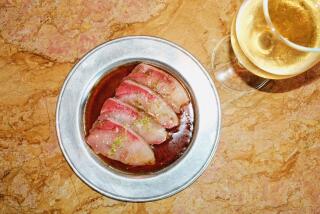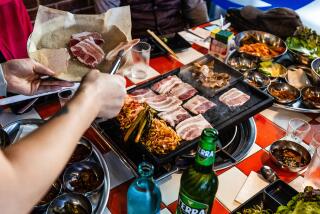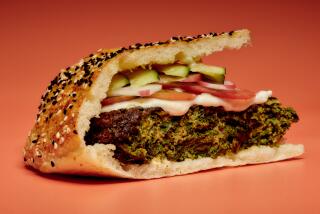SHOPTALK : In Search of the Holy Grill : The barbecue season is here and there’s a big choice in the variety and cost of equipment.
- Share via
Memorial Day Weekend has come and gone. The school year is coming to a close allover Ventura County. And the sun has managed to poke through the coastal clouds.
Are you thinking what we’re thinking?
We don’t need a calendar to know that summer is just around the corner, offering plenty of opportunities for outdoor gatherings with family and friends.
We’re pleased about that--we like our family and friends--but we’re not as pleased as the people who sell barbecues. This is definitely their peak season.
If you are new to the barbecue game, or are looking to switch from your old Weber kettle to something more sophisticated, here are a few tips that may help. We spent a little time last week talking to the folks at Barbeques Galore in Oxnard and Zender’s Patio & Fireside store in Thousand Oaks.
Before you set foot into a barbecue store, the first thing you should know is that prices will range from around $30 to $2,000. The difference depends on size, durability and choice of bells and whistles.
You can get barbecues with fold-out shelves, with burners on the side of the main cooking area, with cast-iron surfaces. You can get them on rolling carts, or built into a wall as part of your patio’s architectural design.
“It’s like the difference between buying a Ford and a Cadillac,” said Vic Evans at Zender’s. “People shouldn’t buy things they won’t use. You may just want a plain and simple barbecue. That’s where you have to make the choice.”
Before even considering price, the first choice you make should be whether you want to cook with charcoal, electricity, gas or wood, or in a smoker. There are pluses and minuses.
Charcoal: Barbecues using charcoal typically come in the form of a round kettle (such as the trusty Weber), or a square, covered grill. Stuart McDonald, manager of Barbeques Galore, said charcoal proponents think it gives the food more flavor than the other modes of barbecuing.
And the downside? “You have to buy the charcoal and light the charcoal,” said McDonald. “You’re going to have a lot of mess, a lot of residue, and a lot of charcoal being wasted.”
Gas: Unlike charcoal, gas doesn’t have to heat up. You just turn a knob. Many gas grills have dual burners, so you can cool one side of the grill, while keeping the other side heated.
One thing to consider when buying a gas barbecue are its BTUs (British Thermal Units). BTUs indicate the speed with which the grill will reach a high level of heat. The higher the number, the faster the heating process.
“BTUs are important for being able to get the maximum performance for searing the chicken or steak,” said McDonald. “But after you sear the food, you lower the heat anyway.”
When choosing a gas barbecue, you will need to decide between using the natural gas at your home or buying propane tanks. Gas barbecues will work with one or the other. Some people prefer natural gas because it is relatively safe and cheap, and there is no risk of running out of it during the cooking process.
Electric: McDonald said people who use electric barbecues tend to be fearful of using gas and would rather not have the mess of charcoal. The problem with electric, he said, is that the heating area is smaller than with the other modes. That’s because there is only so much amperage that can be supplied by a common household outlet.
Smoker: If you like your food to have a smoky flavor, and are willing to really slow down the barbecue process--it takes a minimum of a couple of hours to smoke the food--you may want to consider a smoker--gas, charcoal or electric.
Wood: Wood barbecues are generally the barbecues used at large gatherings for spit-roasting whole animals. Flavors are enhanced by using alder, maple, oak and other types of wood chips.
So now you’re ready to send out the barbecue invitations. All you need is a tall chef’s hat and one of those full-length aprons that says, “Kiss me. I’m the cook.”
More to Read
Sign up for The Wild
We’ll help you find the best places to hike, bike and run, as well as the perfect silent spots for meditation and yoga.
You may occasionally receive promotional content from the Los Angeles Times.






